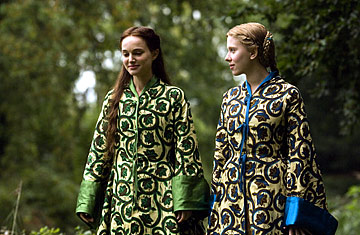
Natalie Portman as Anne Boleyn and Scarlett Johansson as Mary Boleyn in The Other Boleyn Girl.
Who says there are no leading roles for veteran actresses? Two of this week's new movies are star vehicles for three performers who have amassed nearly 40 years of movie experience among them. It just happens that none of these grizzled troupers is older than 28.
Our topic today is child stars, their appeal and limitations. In The Other Boleyn Girl, Natalie Portman, 26, and Scarlett Johansson, 23, play Anne and Mary Boleyn, one destined to be Henry VIII's second wife, the other his mistress. Penelope stars Christina Ricci, 28, in a contemporary fantasy about a girl who has a pig's snout for a nose because, as the family legend goes, a witch's curse had long ago fallen on her ancestors.
All these are challenging roles, not just because the American-bred stars are headlining movies set in ancient or modern London, but because Portman, Johansson and Ricci must cope with audience attitudes toward them that were formed when these women were kids.
Consider their résumés: Christina Ricci, born Feb. 12, 1980, first noticed when she was 10 in Mermaids (as the sister of another child siren, Winona Ryder), then certifying her kid stardom a year later as Wednesday Addams in The Addams Family. Natalie Portman, born June 9, 1981, zoomed to stardom in Luc Besson's Leon, a.k.a. The Professional, when she was 12. Scarlett Johansson, born Nov. 22, 1984, a leading actress at 11 as Manny in Manny & Lo, then at 13 as the troubled girl redeemed by Robert Redford in The Horse Whisperer. All three girls kept acting through their teen years (Portman tucked a Harvard degree and a graduate stint at the Hebrew University of Jerusalem into her work schedule) and have successfully made the transition to adult stars.
Yet something pre-adolescent lingers in the acting of many ex-child stars, which gets in the way of the characters even as it focuses our eyes on the stars. I think it's because kids who stepped before the camera at an early age learned that the most important weapon in their arsenal was their gamine appeal. From the start they were tutored in the art of beguilement, the seductive talent of getting looked at. (These kids wouldn't be on screen if someone hadn't noticed them and said, "You oughta be in pictures.") They have been watched, and aware they're being watched, since grade school. That's a lesson that's hard to unlearn.
And though many kids find ways of getting attention, child stars didn't have to figure out the art of allure through painful improvisation; they were taught by pros. Johansson and Ricci both attended a Manhattan showbiz seminary called the Professional Children's School. ("And what are you studying, little Christina?" "How to be a professional child." "Well, don't stay up all night studying, or you won't look like one.")
I say child stars, not child actors. To oversimplify wildly, a star is someone whose personality monopolizes the screen; an actor is someone who slips into another personality. The star says, "Look at me." The actor says, "Look at the me I'm playing." Of course, nobody in movies is all star or all actor. Every star is playing a role, and every actor reveals bits of himself or herself. But so many child stars, including some of the brilliant ones — Mickey Rooney, Margaret O'Brien, Billy Gray, Patty Duke, Tatum O'Neal — either found it difficult to sustain their appeal as adult actors or relied too long on the tricks they'd picked up as kids.
Boleyn for Calumny
Oh, yes — the movies. The Other Boleyn Girl is based on the Philippa Gregory novel that wove the melodrama of Henry's rule into a bodice-ripping yarn. Not that the known facts aren't salacious enough: the King's impatience with his wife, Catherine of Aragon, in providing him with a male heir; his divorce of Catherine to marry Anne; his break with the Pope over the divorce and his establishment of the Anglican Communion as his own personal church. With all this as backdrop, Gregory foregrounded scenes of calumny and chicanery, of paternal pimping and near-incest, to create an international best-seller that cried out to be visualized. Indeed, the novel was made into a 2003 TV movie, with Jodhi May and Natascha McElhone as Anne and Mary, which was to be released on DVD next month but has been delayed till December to keep from conflicting with the Portman-Johansson movie. So the film now in theaters is actually the other Other Boleyn Girl.
Its script is by Peter Morgan, who won a plethora of prizes for The Queen and The Last King of Scotland and the Broadway play Frost Nixon, so you might expect something more than the puffy costume drama you get. Justin Chadwick, the director, is from TV, and apparently thinks that extreme closeups are as telling on the big screen as the small. No question that Portman's and Johansson's faces merit microscopic attention, but the film has a cramped feeling that turns every urgent, conspiratorial confidence into an italicized shout. That's a shame, because the movie has some excellent supporting skullduggery by Mark Rylance as the Boleyn girls' father, as well as a truly imperious turn by Kristin Scott Thomas as their mother. (She also played Johansson's mother in The Horse Whisperer.)
